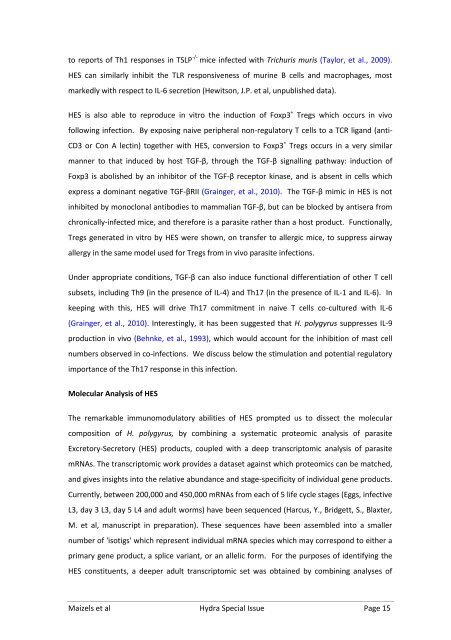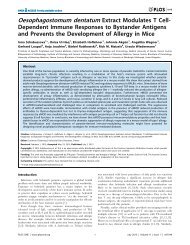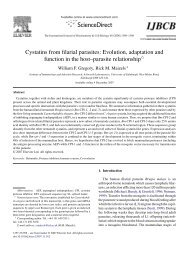Experimental Parasitology - Rick Maizels' Group - University of ...
Experimental Parasitology - Rick Maizels' Group - University of ...
Experimental Parasitology - Rick Maizels' Group - University of ...
You also want an ePaper? Increase the reach of your titles
YUMPU automatically turns print PDFs into web optimized ePapers that Google loves.
to reports <strong>of</strong> Th1 responses in TSLP -/- mice infected with Trichuris muris (Taylor, et al., 2009).<br />
HES can similarly inhibit the TLR responsiveness <strong>of</strong> murine B cells and macrophages, most<br />
markedly with respect to IL-6 secretion (Hewitson, J.P. et al, unpublished data).<br />
HES is also able to reproduce in vitro the induction <strong>of</strong> Foxp3 + Tregs which occurs in vivo<br />
following infection. By exposing naive peripheral non-regulatory T cells to a TCR ligand (anti-<br />
CD3 or Con A lectin) together with HES, conversion to Foxp3 + Tregs occurs in a very similar<br />
manner to that induced by host TGF-β, through the TGF-β signalling pathway: induction <strong>of</strong><br />
Foxp3 is abolished by an inhibitor <strong>of</strong> the TGF-β receptor kinase, and is absent in cells which<br />
express a dominant negative TGF-βRII (Grainger, et al., 2010). The TGF-β mimic in HES is not<br />
inhibited by monoclonal antibodies to mammalian TGF-β, but can be blocked by antisera from<br />
chronically-infected mice, and therefore is a parasite rather than a host product. Functionally,<br />
Tregs generated in vitro by HES were shown, on transfer to allergic mice, to suppress airway<br />
allergy in the same model used for Tregs from in vivo parasite infections.<br />
Under appropriate conditions, TGF-β can also induce functional differentiation <strong>of</strong> other T cell<br />
subsets, including Th9 (in the presence <strong>of</strong> IL-4) and Th17 (in the presence <strong>of</strong> IL-1 and IL-6). In<br />
keeping with this, HES will drive Th17 commitment in naive T cells co-cultured with IL-6<br />
(Grainger, et al., 2010). Interestingly, it has been suggested that H. polygyrus suppresses IL-9<br />
production in vivo (Behnke, et al., 1993), which would account for the inhibition <strong>of</strong> mast cell<br />
numbers observed in co-infections. We discuss below the stimulation and potential regulatory<br />
importance <strong>of</strong> the Th17 response in this infection.<br />
Molecular Analysis <strong>of</strong> HES<br />
The remarkable immunomodulatory abilities <strong>of</strong> HES prompted us to dissect the molecular<br />
composition <strong>of</strong> H. polygyrus, by combining a systematic proteomic analysis <strong>of</strong> parasite<br />
Excretory-Secretory (HES) products, coupled with a deep transcriptomic analysis <strong>of</strong> parasite<br />
mRNAs. The transcriptomic work provides a dataset against which proteomics can be matched,<br />
and gives insights into the relative abundance and stage-specificity <strong>of</strong> individual gene products.<br />
Currently, between 200,000 and 450,000 mRNAs from each <strong>of</strong> 5 life cycle stages (Eggs, infective<br />
L3, day 3 L3, day 5 L4 and adult worms) have been sequenced (Harcus, Y., Bridgett, S., Blaxter,<br />
M. et al, manuscript in preparation). These sequences have been assembled into a smaller<br />
number <strong>of</strong> 'isotigs' which represent individual mRNA species which may correspond to either a<br />
primary gene product, a splice variant, or an allelic form. For the purposes <strong>of</strong> identifying the<br />
HES constituents, a deeper adult transcriptomic set was obtained by combining analyses <strong>of</strong><br />
Maizels et al Hydra Special Issue Page 15





